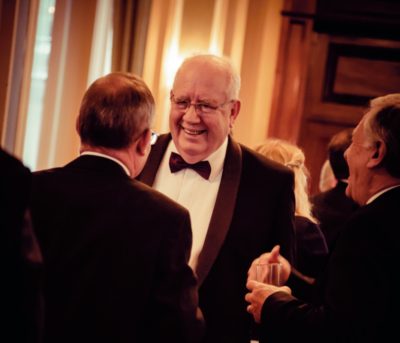
Above: Alan Muddiman MBE, pictured at a recent CECA Yorkshire & The Humber dinner
CECA was delighted to support the award of MBE to Alan Muddiman for his contribution to CECA over the past 25 years and the impact he has had on health & safety in the civil engineering sector.
CECA National Civil Engineering Director Peter Crosland caught up with Alan shortly after he received his award letter and took the opportunity to quiz Alan about all things health & safety.
When asked how he became interested in health and safety Alan replied that when working for a contractor on a Tarmac Construction site in the mid 1970s he was impressed both with the management and the style of communication, remembering a ‘Kitchener’ type poster which resonated (not least because of Alan’s military background).
Alan remembers the poster’s message – “My family expects me to work safe!” – which is resonant with some of the messaging on major highway schemes today. Alan’s view was that the messaging showed significant senior management commitment and this struck a chord with him – giving him a purpose and a passion to work in health and safety.
Over the years, Alan has been fortunate to have bosses who felt that bigger companies should put something back into the industry – allowing him time to help CECA and the Yorkshire Training Centre (YSC) influence the construction industry. And that’s exactly what he’s done.
When asked what areas he had seen most change over the course of his career, Alan said that in the 1970s the majority of construction (HSE) inspectors came from the industry (such as ex-site agents or foremen) and that “you couldn’t pull the wool over their eyes and, if there was a problem, they actually helped in a positive way too, helping out and showing the way how things could be done.”
Another change is in the level of paperwork that is expected to be completed, and this has had serious impact on the industry. Alan’s firm view is that the ‘Agent’ within the contractor role now spends most of his time producing paperwork for the Principal Contractor, instead of being out of the office looking at what’s going on, on the site.
When asked about his main achievements Alan, as much as his modesty would allow, highlighted a particular piece of work he had been instrumental in delivering, namely a Safety Management System for Mowlem.
He had just moved from Tarmac where he had been for fifteen years and was asked if he could write a safety management system for the company.
He went through the whole of the company seeking out what good practice looked like and combined it into one document, a modified form of which is still in use today.
We then moved the topic onto Safety Advisors within the industry. Alan said that Safety Advisors have to be prepared to give both positive and negative feedback when visiting sites. Alan has seen all too often circumstances where the feedback is all negative with some safety advisors simply seeking out bad practice and highlighting defects with photographs, rather than seeing health and safety as part of the project rather than a simple ‘bolt on.’
In Alan’s words, there are people in the industry who will tell you when to stop, however, he is much more sided with the position where you can tell someone when they can start! This is a far more effective way of managing health and safety and ultimately, the overall project.
On the subject of training, I asked Alan’s views on the role of the designer (and being a designer in a previous life I ducked at this point!) and what did and didn’t work. We agreed that the removal of mandatory site training for design engineers was a mistake and that the ICE should look to reintroduce this, as there is substantial evidence from the contracting world about the value of contractors’ staff working in consultant organisations.
An example of good designers was cited as those employed in the design of temporary works. Alan stated that it is not unusual for them to engage with those who can advise whether a design is workable or buildable or not – and that mainstream design engineers could learn ‘a thing or two’ from this approach.
Obviously, members will be aware of Alan’s most recent initiative which was CECA’s CDM 2015 good practice guide for the civil engineering sector – something which Alan was instrumental in bringing to the fore. He is now working with the Yorkshire Safety Centre and CECA National on a further initiative which is capturing good practice via video.
When I asked Alan about the future of the industry he was quite concerned. He stated that the major risk was that civil engineering will not be an appealing industry to sign up to due to the high levels of form-filling required to discharge certain requirements. Alan’s firm view is that civil engineering is about solving problems, not filling in paperwork – therefore as an industry we have to change.
In part, Alan believes we have to return to some of the ways in which we previously operated. This is not a move to so called halcyon days – but a return to what Eagan and Latham extolled – collaboration and a willingness to work together, that is, teamwork. As individuals, we have to be confident to know our own limitations and ask for help when it’s needed.
Wrapping up the interview I asked Alan what the industry could do differently to try and create a step change to what is being done at present.
Alan suggested that the regulator (HSE) dictates the direction of H&S initiatives but we as an industry have not responded in a joined-up way. There is therefore an opportunity for like-minded organisations, including ICE, CECA, ICG and leaders of major companies, to work together to identify what it is we as an industry need to do and then set a clear direction of travel.
One such topic for consideration was the suggestion of introducing an audit programme for CDM, backed by a number of industry organisations, where all companies engaged in CDM activities would be benchmarked and would have to meet a minimum standard and would ultimately pass or fail on audit.
With that, I left Alan to attend to his lovely garden which was baking under the hot Doncaster sun – not something you can say everyday!

